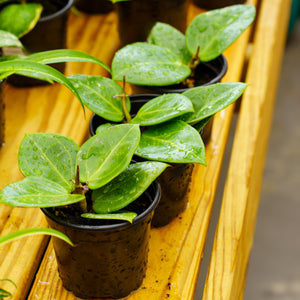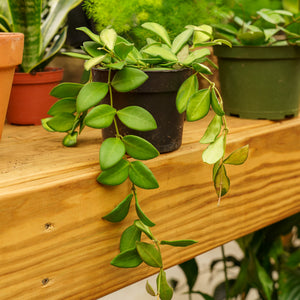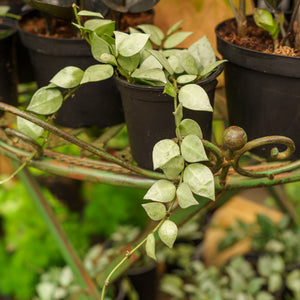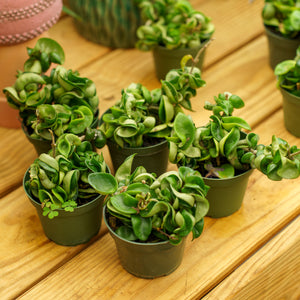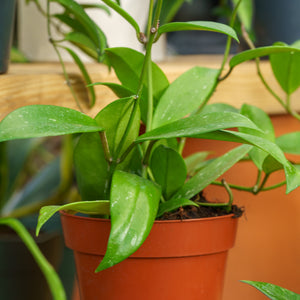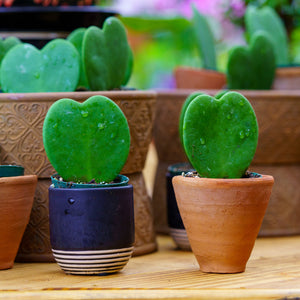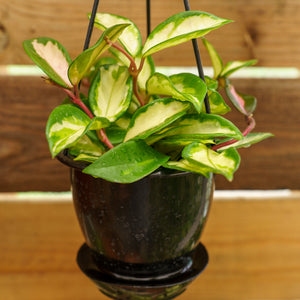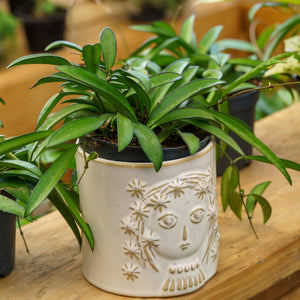The Hoya Guide
Hoyas, often referred to as wax plants, not only bring a touch of elegance and charm to any indoor or garden space with their glossy leaves and clusters of star-shaped, fragrant flowers but also create a calming atmosphere that enhances mental well-being and serves as a natural focal point in any design setting. Known for their unique, waxy appearance and trailing growth habit, Hoya plants are perfect for adding an eye-catching focal point to hanging baskets, containers, and indoor decor. These plants are admired for their ability to thrive in a variety of conditions and their minimal maintenance requirements. Whether you're aiming to enhance your indoor plant collection, create a lush garden display, or add a unique element to your space, Hoyas offer a captivating and versatile solution. Explore our Hoya Guide to learn more about cultivating and caring for these fascinating plants, and discover how to incorporate them into your garden or indoor spaces for lasting beauty and enjoyment.
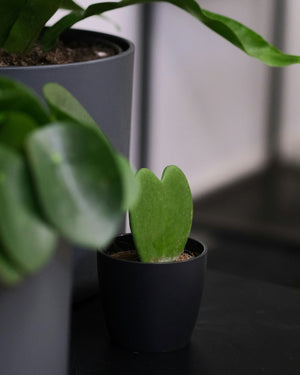
About
Hoyas, commonly known as wax plants or porcelain flowers, belong to the Apocynaceae family and comprise over 200 species of tropical and subtropical plants. Native to Asia, Australia, and the Pacific Islands, Hoyas are renowned for their thick, waxy leaves and clusters of star-shaped, fragrant flowers. The name "Hoya" honors the British botanist Thomas Hoy, who worked with the Duke of Northumberland in the late 18th century.
Hoyas are primarily epiphytic or lithophytic in their natural habitats, meaning they grow on trees or rocks rather than in soil. This growth habit not only highlights their adaptability but also makes them ideal for vertical gardening or space-saving solutions, especially in smaller apartments or compact living spaces. This growth habit allows them to thrive in well-draining, airy conditions. The plants can vary significantly in size, leaf shape, and flower color, offering a diverse range of options for plant enthusiasts. The leaves can be small and round or long and lance-shaped, often with attractive variegation or speckling. The flowers are usually arranged in umbels and can be white, pink, red, or yellow, with a distinctive star-like shape and a sweet fragrance.
One of the most popular species is Hoya carnosa, known for its glossy, green leaves and clusters of pink or white flowers with red centers. Another favorite is Hoya kerrii, also known as the sweetheart plant, which features heart-shaped leaves that make it a popular gift for Valentine’s Day.
Hoyas are celebrated for their resilience and ability to adapt to various indoor environments, making them ideal houseplants for low-maintenance enthusiasts. Beyond their ease of care, these plants contribute to improved indoor air quality and create a calming ambiance, enhancing the overall aesthetic and well-being of any room. They are relatively low-maintenance and can thrive with minimal care, provided they receive the right conditions. Their ability to produce long-lasting, fragrant flowers adds to their appeal, making them a favorite among plant collectors and gardeners alike.
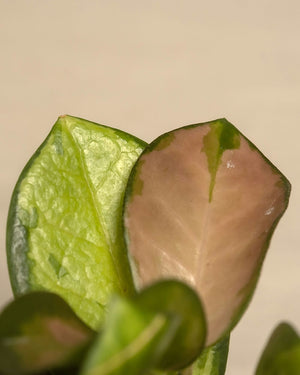
Planting
Proper planting of Hoya plants ensures not only their successful establishment and flourishing growth but also long-lasting beauty and low-maintenance care, enhancing your environment with their unique charm. Here are some essential guidelines for planting and caring for Hoyas:
- Soil: Hoyas prefer a well-draining potting mix that allows air to reach their roots, minimizing the risk of root rot and ensuring healthy growth, which is particularly appealing to beginners. A mix of orchid bark, perlite, and peat moss works well for most Hoya species. This combination ensures good drainage and mimics their natural epiphytic growing conditions.
- Light: Hoyas thrive in bright, indirect light. While they can tolerate lower light conditions, their growth and flowering will be more prolific with more light. Avoid direct sunlight, which can scorch the leaves, especially for indoor plants.
- Watering: Hoyas require regular watering to keep the soil evenly moist but not waterlogged. Water the plant thoroughly, allowing the top inch of soil to dry out between waterings. During the winter months, reduce watering slightly, as the plant's growth slows down.
- Humidity: Hoyas prefer moderate to high humidity levels. Increase humidity by misting the leaves regularly, placing a humidifier nearby, or using a pebble tray with water. This is particularly important for indoor plants, especially in dry environments.
- Temperature: Hoyas thrive in warm temperatures between 60-80°F (16-27°C). Protect the plant from cold drafts and sudden temperature changes, which can cause stress and damage the leaves. In colder climates, Hoyas should be grown as houseplants or in containers that can be brought indoors during the winter.
- Container: Choose a pot with drainage holes to prevent waterlogging. Ensure the container is large enough to accommodate the plant's root system and allows for growth. Hanging baskets are an excellent option for trailing Hoya species.
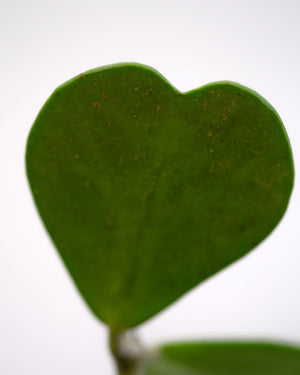
Care
Hoya plants require specific care to ensure their optimal growth and health. Here are some general guidelines for the care of Hoyas:
- Watering: Keep the soil consistently moist but not waterlogged. Water the plant thoroughly, allowing the top inch of soil to dry out between waterings. During the winter months, reduce watering slightly, as the plant's growth slows down. Avoid using hard water, which can cause leaf spots.
- Fertilizing: Hoyas benefit from regular feeding during the growing season. Use a balanced, water-soluble fertilizer diluted to half strength every 4-6 weeks from spring through fall. Avoid over-fertilizing, as this can lead to salt buildup and damage the plant.
- Pruning: Remove any yellow or damaged leaves to maintain the plant's appearance and health. Use clean, sharp scissors to avoid introducing infections. Prune back the tips of the stems to encourage bushier growth if desired. Regular pruning helps maintain the desired shape and size of the plant.
- Pests and Diseases: Hoyas can be susceptible to pests such as spider mites, aphids, and mealybugs. Inspect your plants regularly and treat any infestations promptly with appropriate organic or chemical controls. Maintain proper watering and humidity to reduce the risk of pests and diseases.
- Repotting: Repot Hoyas every 2-3 years or when they outgrow their current container. Spring is the best time to repot. Use fresh potting mix and ensure the new pot has adequate drainage.
- Support: Many Hoya species have a trailing or vining habit and may benefit from support. Use a trellis, stakes, or a hanging basket to encourage the plant to grow upwards and showcase its beautiful foliage and flowers.
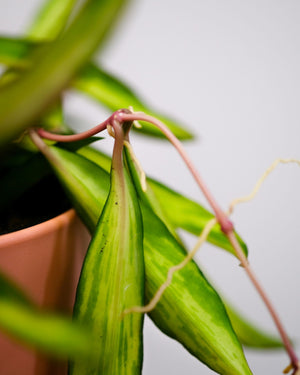
How To Use
Hoyas offer versatility and can be utilized in various ways to enhance your indoor and garden spaces. Here are some recommendations based on their characteristics:
- Indoor Decor: Hoyas make stunning houseplants, offering both a touch of elegance and functional benefits such as improved air quality and a calming atmosphere that enhances any room's aesthetic. Place them in bright, indirect light and use decorative pots to enhance their appearance. Their trailing habit makes them perfect for hanging baskets or shelves.
- Office Plants: Hoyas' ability to thrive in bright, indirect light makes them ideal for office environments. Place them on desks, shelves, or in corners to bring a touch of nature to the workspace. Their air-purifying properties also help improve indoor air quality.
- Hanging Baskets: Grow Hoyas in hanging baskets to create cascading displays of glossy leaves and fragrant flowers. This is an excellent way to showcase their trailing habit and add visual interest to your indoor or outdoor spaces.
- Living Walls: Use Hoyas to create living wall displays. Plant them in vertical planters or frames to add a unique, textural element to indoor or outdoor walls. Their trailing or climbing habits can enhance the visual appeal of vertical gardens.
- Patios and Balconies: Grow Hoyas in containers to create portable displays for patios, balconies, or entryways. Use decorative pots to enhance their sculptural forms and arrange them in groupings for added impact.
- Terrariums: Small Hoya species can be used in terrariums, where their humidity needs can be easily met. Combine them with other tropical plants to create a lush, miniature ecosystem.
- Public Spaces: Hoyas are often used in public spaces like hotel lobbies, restaurants, and office buildings to create a lush, inviting atmosphere that leaves a lasting impression on visitors. Their low maintenance requirements and aesthetic appeal make them ideal for enhancing customer experiences, while their air-purifying properties contribute to a healthier and more pleasant environment. Their low maintenance requirements and striking appearance make them ideal for such settings.
Conclusion
Hoyas are a captivating and versatile addition to any garden or indoor space. With their glossy leaves, fragrant flowers, and minimal maintenance requirements, Hoya plants bring a touch of tropical elegance to your environment. Beyond their visual appeal, they contribute to mental well-being by fostering a calming atmosphere and creating a natural focal point in any design setting. Their trailing vines and clusters of blooms effortlessly enhance the aesthetic charm of both modern and traditional interiors. Their adaptability to various growing conditions and ease of care make them a favorite among gardeners and indoor plant enthusiasts of all levels. By following proper planting and maintenance techniques, you can fully harness the potential of Hoyas to enhance your garden and home, creating a lasting impact.
Whether you seek to create stunning indoor displays, enhance your patio garden, or add visual interest to hanging baskets and living walls, Hoyas can fulfill a variety of roles in your landscape and decor. Place them individually to showcase their unique beauty, or combine different species and varieties for a dynamic and visually appealing display. Hoyas' ability to thrive in diverse environments and provide year-round interest adds to their appeal, making them a valuable addition to any collection.
Beyond their ornamental value, Hoyas contribute to the overall health and beauty of your garden ecosystem by providing habitat for beneficial insects and adding structure to your landscape. Their low maintenance requirements and resilience make them an excellent choice for sustainable gardening. With their enduring beauty, versatility, and ecological benefits, Hoya plants bring natural allure and vibrant charm to your outdoor and indoor environments, enriching your plant collection and enhancing the overall beauty of your space.

